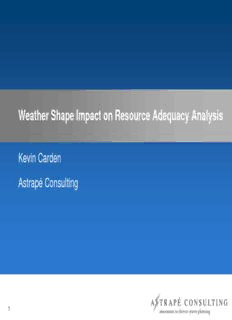
Weather Shape Impact on Resource Adequacy Analysis PDF
Preview Weather Shape Impact on Resource Adequacy Analysis
Weather Shape Impact on Resource Adequacy Analysis Kevin Carden Astrapé Consulting 1 Astrapé Consulting MISO CPUC Astrapé Clients – Economic/Physical PG&E SPP NCEMC Astrapé Clients –Physical Reliability Duke TVA PNM Santee Southern Entergy Cooper Company ERCOT CLECO 22 Resource Adequacy Framework Capture Uncertainty in the Following Variables Weather (35 years of weather history) Impact on Load and Resources (hydro, wind, PV, temp derates on thermal resources) Economic Load Forecast Error (distribution of 5 points) Unit Outage Modeling (100+ iterations) Multi-Area Modeling – Pipe and Bubble Representation Adjust reserve margin levels using either load or generation Total Base Case Scenario Breakdown 35 5 175 x = Weather Years LFE Points Load Scenarios (Equal Probability) (Associated Probabilities) (Associated Probabilities) 175 x 100 = 17,500 Load Scenarios Unit Outage Draws 8760 Hour Simulations 33 Incorporating Weather Uncertainty for Load • Collect Recent Hourly Loads 1. Develop Load/Weather • Collect Recent Weather Data Relationship • Normalize to Single Base Year • Train using Neural Network Software • Collect 1980-2016 Temperature 2. Apply Relationship to Create Synthetic Shapes 3. Scale Loads 4. Simulate Study from Base Year Year with Each to Future Study Shape Year 44 Demo Study Setup 2 Zone System (Zone A & B) Each Zone ~1800 MW peak load Summer Peaking with 15% Renewable Penetration Economically Committed and Dispatched 1000 MW Transfer Capability 55 Load Modeling: Summer Peak Weather Variability 8.0% 6.0% r e h 4.0% t a e W 2.0% l a m r o 0.0% N m o r -2.0% f % -4.0% System Average Peak Temperature: 98.2 ◦F System Max Peak Temperature: 104.4 ◦F -6.0% 2 1 2 2 1 1 1 1 1 2 2 1 2 1 1 1 2 2 2 1 2 1 2 1 2 2 2 1 2 1 1 1 1 1 2 1 0 9 0 0 9 9 9 9 9 0 0 9 0 9 9 9 0 0 0 9 0 9 0 9 0 0 0 9 0 9 9 9 9 9 0 9 0 8 0 0 8 9 9 8 8 0 0 8 0 9 8 8 0 1 1 9 0 9 1 9 0 0 1 9 1 9 8 9 8 8 1 9 4 7 1 0 4 7 9 8 6 8 9 2 5 2 5 3 6 2 1 6 2 3 4 1 7 3 0 8 5 5 1 0 9 0 3 4 Year 66 Zone A Weather Duration Curve Top 200 Hours 105 1994 103 1980 101 1998 1999 99 ) F 1992 ° ( 97 e 1993 r u t 95 2000 a r e 2009 p 93 m 1985 e T 91 1996 2001 89 1988 87 1984 2004 85 0 50 100 150 200 Hour 77 Zone A Load Duration Curve (Original Unscaled) Top 200 Hours 1800 1994 1980 1750 1998 1700 1999 1992 1650 ) W 1993 M ( 1600 2000 d a o 2009 L 1550 1985 1500 1996 2001 1450 1988 1984 1400 0 50 100 150 200 2004 Hour 88 Time of 10 Highest Loads in Each Weather Year 11 1980 1981 10 1982 1983 9 1984 1985 8 1986 1987 s d 1988 1989 a o 7 L 1990 1991 t s 6 1992 1993 e h g 1994 1995 i 5 H 1996 1997 0 1 4 1998 1999 p o 2000 2001 T 3 2002 2003 2 2004 2005 2006 2007 1 2008 2009 0 2010 2011 1 1 2 3 4 5 5 6 7 8 8 9 1 1 1 1 / / / / / / / / / / / / 0 1 2 2 1 2 1 1 7 1 2 1 1 5 2 2 2012 2013 / / / / 5 8 4 5 8 2 9 2 1 9 3 2 6 7 2014 2015 Date 99 Seasonal Load Variability Multiple-Shape approach captures off-peak risk better than single shape May and September show highest variance in load over 34 year period Max September peak could be >20% 170,000 25% above normal September peak 160,000 20% r e 150,000 h ta Normal Weather e 140,000 W ) 15% W l a M m 130,000 ( r d o a 10% N Max Across 33 o 120,000 L m Weather Years o r 110,000 F 5% % 100,000 Max % Away from Normal Weather 90,000 0% (Secondary Axis) 1 2 3 4 5 6 7 8 9 10 11 12 Month 1100
Description: